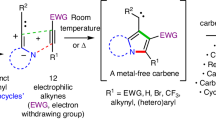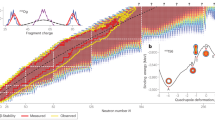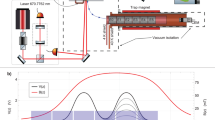Abstract
The periodic table provides an intuitive framework for understanding chemical properties. However, its traditional patterns may break down for the heaviest elements occupying the bottom of the chart. The large nuclei of actinides (Z > 88) and superheavy elements (Z ≥ 104) give rise to relativistic effects that are expected to substantially alter their chemical behaviours, potentially indicating that we have reached the end of a predictive periodic table1. Relativistic effects have already been cited for the unusual chemistry of the actinides compared with those of their lanthanide counterparts2. Unfortunately, it is difficult to understand the full impact of relativistic effects, as research on the later actinides and superheavy elements is scarce. Beyond fermium (Z = 100), elements need to be produced and studied one atom at a time, using accelerated ion beams and state-of-the-art experimental approaches. So far, no experiments have been capable of directly identifying produced molecular species. Here ions of actinium (Ac, Z = 89) and nobelium (No, Z = 102) were synthesized through nuclear reactions at the 88-Inch Cyclotron facility at Lawrence Berkeley National Laboratory and then exposed to trace amounts of H2O and N2. The produced molecular species were directly identified by measuring their mass-to-charge ratios using FIONA (For the Identification Of Nuclide A)3. These results mark the first, to our knowledge, direct identification of heavy-element molecular species using an atom-at-a-time technique and highlight the importance of such identifications in future superheavy-element chemistry experiments to deepen understanding of their chemical properties.
This is a preview of subscription content, access via your institution
Access options
Access Nature and 54 other Nature Portfolio journals
Get Nature+, our best-value online-access subscription
$32.99 / 30 days
cancel any time
Subscribe to this journal
Receive 51 print issues and online access
$199.00 per year
only $3.90 per issue
Buy this article
- Purchase on SpringerLink
- Instant access to full article PDF
Prices may be subject to local taxes which are calculated during checkout



Similar content being viewed by others
Data availability
The data to support the findings of this study are available on Zenodo (https://zenodo.org/records/14277708)53.
Code availability
The code used to analyse the findings of this study is available on Zenodo (https://zenodo.org/records/14277708)53.
References
Smits, O. R., Düllmann, C. E., Indelicato, P., Nazarewicz, W. & Schwerdtfeger, P. The quest for superheavy elements and the limit of the periodic table. Nat. Rev. Phys. 2, 515–531 (2020).
The Chemistry of the Actinide and Transactinide Elements Vol. 1–5 (Springer, 2006).
Gates, J. M. & Pore, J. L. Studies of heavy and super heavy elements with FIONA: the broad impact of mass-number identifications. Eur. Phys. J. A 58, 196 (2022).
Miederer, M., Scheinberg, D. A. & McDevitt, M. R. Realizing the potential of the actinium-225 radionuclide generator in targeted alpha particle therapy applications. Adv. Drug Deliv. Rev. 60, 1371–1382 (2008).
Deblonde, G. J.-P., Zavarin, M. & Kersting, A. B. The coordination properties and ionic radius of actinium: a 120-year-old enigma. Coord. Chem. Rev. 446, 214130 (2021).
Wacker, J. N. et al. Actinium chelation and crystallization in a macromolecular scaffold. Nat. Commun. 15, 5741 (2024).
Silva, R. J. in The Chemistry of the Actinide and Transactinide Elements (eds Morss, L. R., Edelstein, N. M. & Fuger, J.) 1621–1651 (Springer, 2006).
Sato, T. K. et al. First ionization potentials of Fm, Md, No, and Lr: verification of filling-up of 5f electrons and confirmation of the actinide series. J. Am. Chem. Soc. 140, 14609–14613 (2018).
Laatiaoui, M. et al. Atom-at-a-time laser resonance ionization spectroscopy of nobelium. Nature 538, 495–498 (2016).
Schädel, M. Chemistry of the superheavy elements. Philos. Trans. R. Soc. A Math. Phys. Eng. Sci. 373, 20140191 (2015).
Gregorich, K. E. Simulation of recoil trajectories in gas-filled magnetic separators. Nucl. Instrum. Methods Phys. Res. A 711, 47–59 (2013).
Savard, G. Large radio-frequency gas catchers and the production of radioactive nuclear beams. J. Phys. Conf. Ser. 312, 052004 (2011).
Cooper, K. et al. Extraction of thermalized projectile fragments from a large volume gas cell. Nucl. Instrum. Methods Phys. Res. A 763, 543–546 (2014).
Sumithrarachchi, C. S. et al. Beam thermalization in a large gas catcher. Nucl. Instrum. Methods Phys. Res. B 463, 305–309 (2020).
Anderson, J. B., Andres, R. P. & Fenn, J. B. in Advances in Chemical Physics: Molecular Beams Vol. 10 (ed. Ross, J.) 275–317 (Interscience, 1966).
Hillenkamp, M., Keinan, S. & Even, U. Condensation limited cooling in supersonic expansions. J. Chem. Phys. 118, 8699–8705 (2003).
Northby, J. A. Experimental studies of helium droplets. J. Chem. Phys. 115, 10065–10077 (2001).
Searcy, J. Q. & Fenn, J. B. Clustering of water on hydrated protons in a supersonic free jet expansion. J. Chem. Phys. 61, 5282–5288 (1974).
Herfurth, F. et al. A linear radiofrequency ion trap for accumulation, bunching, and emittance improvement of radioactive ion beams. Nucl. Instrum. Methods Phys. Res. A 469, 254–275 (2001).
Lunney, M. D. & Moore, R. B. Cooling of mass-separated beams using a radiofrequency quadrupole ion guide. Int. J. Mass Spectrom. 190–191, 153–160 (1999).
Mansell, S. M., Farnaby, J. H., Germeroth, A. I. & Arnold, P. L. Thermally stable uranium dinitrogen complex with siloxide supporting ligands. Organometallics 32, 4212–4218 (2013).
Schädel, M. et al. Chemical properties of element 106 (seaborgium). Nature 388, 55–57 (1997).
Eichler, R. et al. Chemical characterization of bohrium (element 107). Nature 407, 63–65 (2000).
Düllmann, Ch. E. et al. Chemical investigation of hassium (element 108). Nature 418, 859–862 (2002).
Eichler, R. et al. Chemical characterization of element 112. Nature 447, 72–75 (2007).
Even, J. et al. Synthesis and detection of a seaborgium carbonyl complex. Science 345, 1491–1493 (2014).
Eichler, R. et al. Indication for a volatile element 114. Radiochim. Acta 98, 133–139 (2010).
Yakushev, A. et al. Superheavy element flerovium (element 114) is a volatile metal. Inorg. Chem. 53, 1624–1629 (2014).
Yakushev, A. et al. On the adsorption and reactivity of element 114, flerovium. Front. Chem. 10, 976635 (2022).
Yakushev, A. et al. Manifestation of relativistic effects in the chemical properties of nihonium and moscovium revealed by gas chromatography studies. Front. Chem. 12, 1474820 (2024).
Rutkowski, P. X. et al. Hydration of gas-phase ytterbium ion complexes studied by experiment and theory. Theor. Chem. Acc. 129, 575–592 (2011).
Cheng, P., Koyanagi, G. K. & Bohme, D. K. Gas-phase reactions of atomic lanthanide cations with D2O: room-temperature kinetics and periodicity in reactivity. ChemPhysChem 7, 1813–1819 (2006).
Cheng, P., Koyanagi, G. K. & Bohme, D. K. Heavy water reactions with atomic transition-metal and main-group cations: gas phase room-temperature kinetics and periodicities in reactivity. J. Phys. Chem. A 111, 8561–8573 (2007).
Gates, J. M. et al. First direct measurements of superheavy-element mass numbers. Phys. Rev. Lett. 121, 222501 (2018).
Leitner, D. et al. Next generation ECR ion sources: first results of the superconducting 28 GHz ECRIS—VENUS. Nucl. Instrum. Methods Phys. Res. B 235, 486 (2005).
Parr, R. G. & Yang, W. Density-Functional Theory of Atoms and Molecules (Oxford Univ. Press, 1989).
Becke, A. D. Density‐functional thermochemistry. III. The role of exact exchange. J. Chem. Phys. 98, 5648–5652 (1993).
Lee, C., Yang, W. & Parr, R. G. Development of the Colle-Salvetti correlation-energy formula into a functional of the electron density. Phys. Rev. B 37, 785–789 (1988).
Kendall, R. A., Dunning, T. H. Jr & Harrison, R. J. Electron affinities of the first-row atoms revisited. Systematic basis sets and wave functions. J. Chem. Phys. 96, 6796–6806 (1992).
Cao, X. & Dolg, M. Segmented contraction scheme for small-core actinide pseudopotential basis sets. J. Mol. Struct. THEOCHEM 673, 203–209 (2004).
Cao, X., Dolg, M. & Stool, M. Valence basis sets for relativistic energy-consistent small-core actinide pseudopotentials. J. Chem. Phys. 118, 487–496 (2003).
Bartlett, R. J. & Musial, M. Coupled-cluster theory in quantum chemistry. Rev. Mod. Phys. 79, 291–352 (2007).
Jong, W. A., de Harrison, R. J. & Dixon, D. A. Parallel Douglas–Kroll energy and gradients in NWChem: estimating scalar relativistic effects using Douglas–Kroll contracted basis sets. J. Chem. Phys. 114, 48–53 (2001).
Feng, R. & Peterson, K. A. Correlation consistent basis sets for actinides. II. The atoms Ac and Np–Lr. J. Chem. Phys. 147, 084108 (2017).
Wolf, A., Reiher, M. & Hess, B. A. The generalized Douglas–Kroll transformation. J. Chem. Phys. 117, 9215–9226 (2002).
Knowles, P. J., Hampel, C. & Werner, H.-J. Coupled cluster theory for high spin, open shell reference wave functions. J. Chem. Phys. 99, 5219–5228 (1993).
Reed, A. E., Curtiss, L. A. & Weinhold, F. Intermolecular interactions from a natural bond orbital, donor-acceptor viewpoint. Chem. Rev. 88, 899–926 (1988).
Glendening, E. D., Landis, C. R. & Weinhold, F. NBO 7.0: new vistas in localized and delocalized chemical bonding theory. J. Comput. Chem. 40, 2234–2241 (2019).
Glendening, E. D. et al. NBO 7.0. Theoretical Chemistry Institute, Univ. Wisconsin (2018).
Frisch, M. J. et al. Gaussian 16, revision A.03. Gaussian, Inc. (2016).
Werner, H.-J. et al. The Molpro quantum chemistry package. J. Chem. Phys. 152, 144107 (2020).
Werner, H.-J. et al. MOLPRO, version 2021, a package of ab initio programs. https://www.molpro.net (2021).
Pore, J. Nobelium and actinium coordination chemistry study with FIONA. Zenodo https://zenodo.org/records/14277708 (2024).
Acknowledgements
We gratefully acknowledge the operations staff of the 88-Inch Cyclotron. The work of J.L.P., J.M.G., J.A.G. and R.O. was supported in part by the US Department of Energy, Office of Science, Office of Nuclear Physics under contract no. DE-AC02-05CH11231 (LBNL). The work of J.L.P., J.M.G., J.K.G., M.M., Z.S. and D.K.S. was supported by the US Department of Energy, Office of Science, Office of Basic Energy Sciences, Heavy Element Chemistry Program under contract number DE-AC02-05CH11231 (LBNL). The University of Alabama work of D.A.D. and S.S. was supported by the US Department of Energy, Office of Science, Office of Basic Energy Sciences, Heavy Element Chemistry Program through grant no. DE-SC0018921. D.A.D. thanks the Robert Ramsay Fund at the University of Alabama. F.H.G. was supported through a LBNL Laboratory Directed Research and Development programme.
Author information
Authors and Affiliations
Contributions
J.L.P., J.M.G., M.M., J.K.G. and D.A.D. conceived the study. J.L.P., J.M.G., F.H.G., M.M. and R.O. prepared the experiment. J.L.P., J.M.G., F.H.G., J.K.G., J.A.G., M.M., R.O., Z.S. and D.K.S. participated in the experimental measurements. J.L.P. analysed the experimental data. D.A.D. and S.S. performed the electronic structure calculations. J.L.P., J.M.G., D.A.D., J.K.G. and D.K.S. were responsible for the interpretation of the experimental results. J.L.P. wrote the paper. J.L.P., D.A.D. and S.S. prepared materials for the Supplementary Information. All authors reviewed and edited the paper.
Corresponding author
Ethics declarations
Competing interests
The authors declare no competing interests.
Peer review
Peer review information
Nature thanks Robert Eichler, Alexander Yakushev and the other, anonymous, reviewer(s) for their contribution to the peer review of this work.
Additional information
Publisher’s note Springer Nature remains neutral with regard to jurisdictional claims in published maps and institutional affiliations.
Supplementary information
Supplementary Information
This Supplementary Information file contains the following three sections: S1: Secondary production formation for Ac2+ and No2+ reactions with H2O; S2: Electronic structure calculations; S3: Residual Gas Analyzer Readings. It includes 16 Supplementary Figures, 12 Supplementary Tables, and additional references.
Rights and permissions
Springer Nature or its licensor (e.g. a society or other partner) holds exclusive rights to this article under a publishing agreement with the author(s) or other rightsholder(s); author self-archiving of the accepted manuscript version of this article is solely governed by the terms of such publishing agreement and applicable law.
About this article
Cite this article
Pore, J.L., Gates, J.M., Dixon, D.A. et al. Direct identification of Ac and No molecules with an atom-at-a-time technique. Nature 644, 376–380 (2025). https://doi.org/10.1038/s41586-025-09342-y
Received:
Accepted:
Published:
Issue date:
DOI: https://doi.org/10.1038/s41586-025-09342-y



